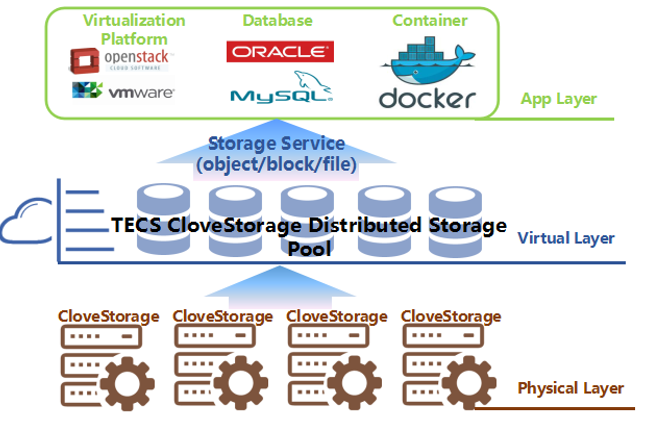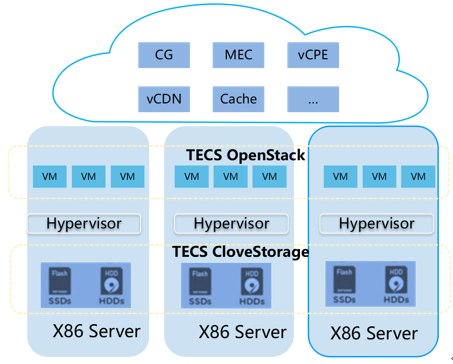Telcos are facing challenges and opportunities brought by network transformation from traditional network to SDN/NFV. Data Center (DC) is going to be the core carrier of future telecom network. Telcos have got the consensus that SDN/NFV network will be based on the three-layer DC architecture (center DC, region DC, and edge DC).
Compared with Internet companies, teclos has massive close-to-user local edge DCs which is their core advantage and important asset. Edge DC covers local network, meeting local service access, and focusing on low latency and user experience improvement. User plane is moved to the edge DC to shorten service response time. Computing capability can also be moved to the mobile edge node to achieve faster release and download of network services and applications by making use of local content and real-time information of the edge node. Thus, it effectively relieves the pressure of mobile core network and improves telecom service environment, to provide users with better network experience.
Distributed software-defined storage is the core of convergence
Distributed software-defined storage is considered as the core of convergence. ZTE distributed unified storage system TECS CloveStroage is based on Ceph. It leverages the design principle of high performance, high reliability, and high scalability to build fully distributed storage pools by organizing local storage resources of common hardware through system software.
TECS CloveStorage enhances protocol standards of object/file/block storage, improves storage management function, and implements performance turning, to address applications in real production environment. It can fully meet future service demands of enterprises, helping them carry out IT system transformation. In addition, TECS CloveStorage enhances the open source architecture, making it meeting carrier-grade requirements of performance, reliability and security, and meeting telecom cloud network deployment requirements in the CT scenario.

Figure 1 Architecture of Carrier-Grade Distributed Storage Platform System
Due to rich functions, excellent high scalability, ease of use, and continuous decrease of TCO, distributed storage just conforms to current telecom cloud services. It shows its value in the following aspects. Through the software-defined approach, it facilitates the decoupling of telecom services and hardware. Common X86 server avoids vendor lock-in. Software features such as flexible expansion achieves the automated deployment and elastic scale-in/out of telecom service bearer network. Besides, the improvement of software and hardware compatibility indirectly improves resource utilization efficiency, guaranteeing system response speed. In addition, distributed storage optimizes traditional O&M procedure and collaborates with the overall service orchestration to shorten service deployment and expansion periods and reduce TCO.
Edge cloud computing and storage convergence solution
In response to service characteristics of the edge telecom cloud, ZTE introduces an infrastructure solution for computing and storage convergence deployment. This is a process in which resources such as computing, network, and storage are used as basic components to be selected and predefined according to system requirements. This approach is based on existing hardware modules and enables rapid expansion, and if different modules are compatible with each other, the expansion process will be very simple. From a storage perspective, the infrastructure of computing and storage convergence deployment is even more interesting; from a hardware perspective, centralizing computing, network, and storage on the same platform is an ideal migration approach.
Edge DC is close to users, so services deployed at edge DC feature in low latency, improving user experience. It includes the following services:
- Mobile voice service: The MGW (Media Plane Gateway) is used as the bearer NE for voice switching. Its completes media resource processing, media conversion, and bearer control functions to support network entities of different call related services.
- Mobile data service: The GW-U (media plane processing) is moved to edge DC, to improve response speed of mobile data services, and improve user experience.
- Fixed network services: In the vBRAS architecture, vBRAS-C is responsible for managing and controlling users in a wide range, so it is deployed in the region DC or center DC. vBRAS-U is responsible for forwarding user data packet, so it is moved to edge DC, to improve experiences of broadband users, and improve response speed of Internet surfing and video.
- CDN service: With the popularization of mobile video service, 4K video and other large bandwidth services, CDN is deployed at edge DC to address most of video requirements of users through local CDN, greatly improving user experience and reducing network load.
- 5G service / MEC service: In the 5G era, service scenarios of mobile communications explores from simple pipe service provision to communication pipe related services.
- Appeal for 5G transformation: 5G needs new business model to break pipe barriers and bring services from the cloud to the edge.
Mobile operators, application developers and content providers work more closely to establish a new value chain, bringing benefits to everybody.
Based on the deep convergence of hypervisor, this distributed software-defined storage solution has the following features.
1. Elastic scale-in/out
CloveStorage provides distributed storage cluster supporting concurrent access. The storage cluster client and each OSD daemon use CRUSH algorithm, to effectively compute information about data location instead of relying on a central lookup table. Distributed storage also provides autonomy and self-healing capabilities, as well as dynamic load balancing and automatic error recovery of cluster; it supports flexible expansion mode, to independently expand hard disk storage nodes, or simultaneously; it supports to add or remove OSD or nodes, without involving extra or irrelevant data transmission.
2. High performance and reliability
Computing is ensured to be close to storage through optimization by CRUSH algorithm, so as to shorten I/O delay and reduce the access frequency to store resources through the network, greatly improving performance. Dynamic scaling can automatically adjust the workload and resources of core applications. SLA can be evenly distributed through QoS assurance.
3. Low cost
At the edge access layer, it uses All-In-One solution to achieve deep integration of computing, storage and network, to reduce procurement cost. At the edge city layer, it uses common X86 server to reduce procurement cost.

Figure 2 Infrastructure Architecture of Computing and Storage Convergence
Computing and storage convergence also brings practical value to edge telecom cloud customers. The sharing of computing and storage resources can save hardware and reduce infrastructure construction costs by more than 50%. Through rapid planning and deployment, the TTM (time-to-market) of storage services can be within 15 minutes. Service application components can be flexibly customized, and after pre-installation and deployment, they can go live by starting he server on site. In addition, the management and maintenance are greatly simplified through unified O&M interface and unified resource orchestration.
Conclusion
The telecom network has entered the 5G era, and the development of edge cloud computing is in full swing. The transition to edge computing is a paradigm shift in IT infrastructure, for example, from the mainframe to the desktop, to the local DC, and then to the cloud DC. As more and more data is generated, processed, and stored in more places, infrastructure management and data security, privacy, and management are all more important than ever. ZTE computing and storage convergence solution just fits the needs of current edge cloud computing development. It has reasonable elastic scalability, richer data processing types, better performance and availability, and more energy-efficient hardware solutions. It provides more options for subsequent edge computing infrastructure construction, to accelerate the development of edge cloud computing.
ZTE supports AI with full-stack IT offering
5GC Green Engine Solution to Enable Green Internet of Everything in the Dual-Carbon Era
5GC Private Network 2.0 Empowerment and Efficiency Improvement Boosts High-Quality Development of the Industry
5G Empowers Intelligent Mining for High-quality Development of Shaanxi Coal Caojiatan Mining
ZTE and China Mobile embrace digitalization for biodiversity conservation in Panda Reserve
Three Aspects Contribute to ZTE’s Remarkable Breakthroughs in Advanced G4X Server
How 5G Private Networks Are Poised to Transform Enterprises Worldwide: All Scenario Private 5G Helps Operators to Realize Private 5G as a Service
ZTE’s commitment to servers generates robust growth of up to 60 times in past 8 years
ZTE eyes top 5 global server market share
Full-Scenario One-Stop 5G Private Network for Vertical Industries

